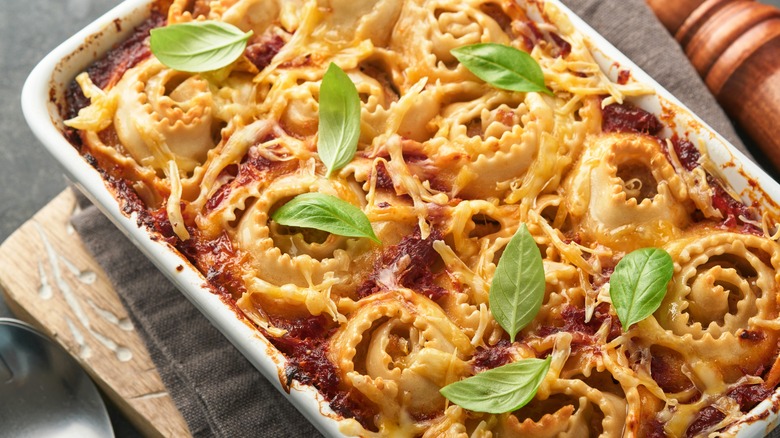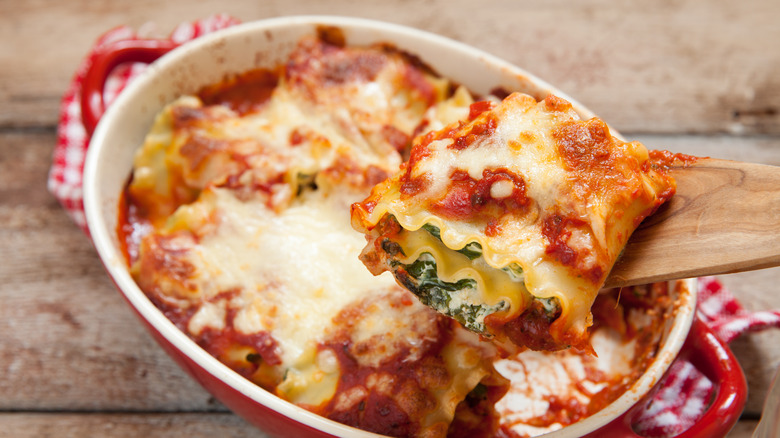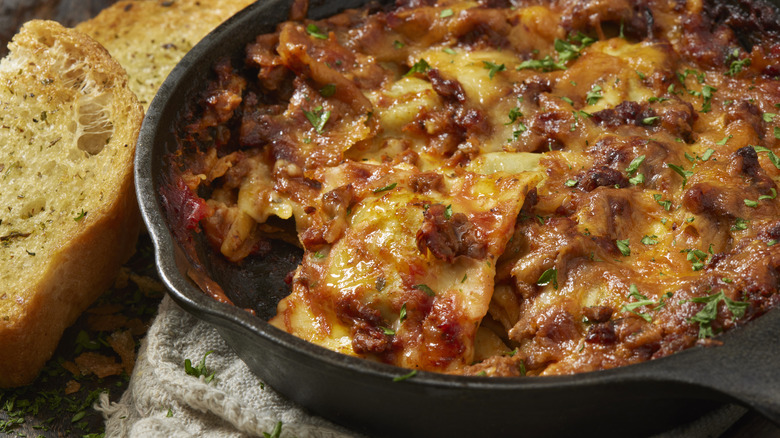Roll Up Your Lasagna Noodles For A Crispy Twist On The Classic
The scent of spices and garlic in the air, the decadence of melted cheese and bubbling sauce — there's no culinary comfort quite like a classic lasagna. It's hearty, delicious, and steeped in tradition. Lasagna is considered one of Italy's oldest dishes, having appeared in medieval literature around the time of Marco Polo. And although there is some origination credit to give to Ancient Greece and its laganon (strips of dough now thought by some to be the first pasta), lasagna is nearly synonymous with Italian cuisine. A dish like that, though, with so much history, has had its fair share of variations. Different regions of Italy serve up their takes — Naples often includes small meatballs and hard-boiled eggs while Genoa substitutes pesto for meat sauce — and chefs all over the world put their spin on the recipe.
Those recipe spins don't have to be huge deviations from the classic, though. Just taking a different approach to structure can cut down on time, create some deliciously crispy edges, and make serving much easier — so set the layers aside and start rolling your lasagna. Rolled lasagna takes all the same ingredients as the classic dish, so you'll still be able to enjoy the rich flavors you know and love, just with a well-baked, golden-brown finish.
Two ways to let it roll
If you want to follow in the footsteps of NYC's Don Angie, who drew inspiration from cinnamon rolls to craft a pinwheel-style lasagna they showcased on Instagram. For this method, you'll need all the lasagna basics — béchamel, bolognese, cheese, and, of course, pasta. Rather than the wavy-edged lasagna noodles you'd get in a box at the store, though, this rolling method calls for a pasta sheet. You'll layer the béchamel on top of one pasta sheet (an important step, since this sauce will hold everything together), sprinkle the cheeses, then set another pasta sheet on top and add the bolognese. Then summon your burrito-rolling skills, because the principle is the same to roll the layered sheets into a log. After refrigerating the lasagna log to let the ingredients set, cut it into slices to get pinwheels.
The second method takes the same ingredients, except that instead of pasta sheets, you'll use the standard ruffled lasagna noodles. Once you spoon cheese and meat sauce along a noodle, start at one end and roll it up tightly — then repeat for each wheel.
Both methods require less labor-intensive layering, and you can make them as simple or as involved as you like. Use pre-made sauces or dish out your own; grab fresh pasta from the grocery store, cook up some dried noodles, or make some from scratch. Since the dish isn't as thick as traditional lasagna, it also needs less time to cook. While it's cooking, though, the pasta's exposed edges will become golden brown and have a beautifully crispy texture.
Keeping spinning the dish
It doesn't take a huge variation of the classic lasagna preparation to create something delicious — and rolling isn't the only technique you can use to switch things up. Heat up your stovetop for a skillet version of lasagna that can be made all in one pan. This easy weeknight dish takes a lot of prep time and mess out of the cooking equation. And speaking of cutting down on time and mess, cooking a lasagna in the air fryer is quick and another way to get a crispy outer layer. If you're making lasagna for a dinner party and need less hands-on time in the cooking process, the dish can even be made in a slow cooker.
Once you master the techniques, your new methods can be transferred to any lasagna style. You can stick with the traditional bolognese-based ingredients, try some of your favorite flavors, or roll up something special.


